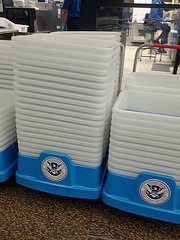The TSA’s Solution For My Reluctance To Open Baby Food Jars? A Pat-Down
Daniel and his family were recently going through the security checkpoint at Logan International in Boston. Traveling with a 10-month-old, the parents have grown used to the hassles of having all of their additional baby-related items scrutinized.
“Whether it’s putting expressed milk that my wife worked so hard to produce in a special scanner or complaining about the consistency of an ice pack, I always make sure to leave a ton of time,” he writes.
And so when they got to the checkpoint in Boston, he wasn’t surprised when the agent asked him to remove all the all jarred baby food from their luggage.
What he wasn’t expecting was a request from the agent to actually open the jars. While the TSA’s published policies do say that it has the authority to request that baby food containers be opened, actually unsealing the food jars is problematic as, once the lids are opened, the contents need to be refrigerated within an hour or be tossed out. Given that the family still had hours of traveling in front of them, opening the jars would effectively be the same as being told to throw them in the trash.
When Daniel brought this up to the agent, he says he was given an ultimatum: Open up the jars or either he or his wife would be subject to a pat-down.
This didn’t seem to make much sense to him and his wife. What good would a pat-down do when the concern was about what was in the jars of baby food? And why only one of them?
“When I asked the agent for the reason, pointing out the obvious flaw in their logic, he responded that we were now suspicious as passengers, and had to undergo extra screening,” recalls Daniel. “Of course, that suspicion only extended as long as we refused to open the jars–if we changed our mind, we could be on our way, grope-free.”
Daniel agreed to the pat-down so that the family could get on its way to the gate, but the questions still linger.
“If you think the food is explosive, insist that we throw it away! If you think we are dangerous, insist that both my wife an I submit to a pat-down!” he says. “In either of those situation, I would disagree with their assessment, but at least I would understand.”
We asked a rep for the TSA why Daniel would be subjected to a pat-down when the agent’s concern was about the contents of the jars. Here is the agency’s response:
TSA allows passenger’s to travel with medically necessary liquids and gels, including medicines, baby food and breast milk, in excess of 3.4 ounces and we ask passengers to show these items to our officers at the checkpoint so they can be screened separately. TSA uses technology called a Bottled Liquid Scanner (BLS) to screen these items at the checkpoint. Use of this technology does not require that the jars or bottles be opened. If, however, the jars or bottles cannot be screened with the BLS, like in this case, because the food labels completely covered the jars, TSA officers will employ liquid test strips to screen the contents. Use of the strips requires that the jars or bottles be opened. TSA does note on our website that officers may need to open these items to conduct additional screening. If the passenger refuses to allow officers to screen the liquids or gels in the manner necessary, standard protocol calls for the passenger to undergo secondary screening, which includes a pat down and swabbing of his/her bags and possibly his/her hands with our Explosive Trace Detection (ETD) equipment. Absent the proper screening of the liquids or gels, the secondary screening and use of ETD will alert officers if the passenger has been handling explosive materials.
That still doesn’t explain why only one of the parents needed to undergo the secondary screening. Just because dad is free of explosives doesn’t mean mom is.
Want more consumer news? Visit our parent organization, Consumer Reports, for the latest on scams, recalls, and other consumer issues.


